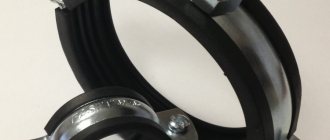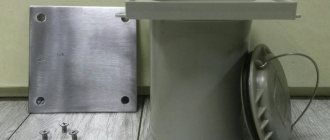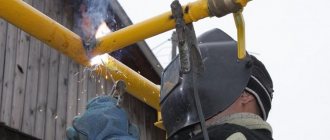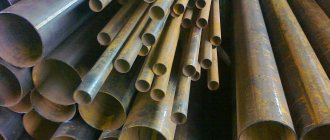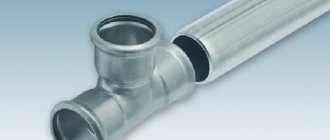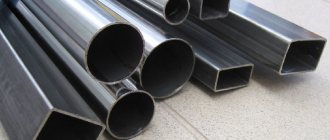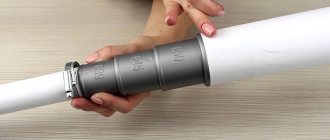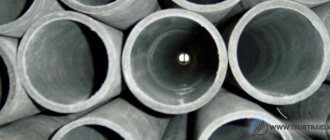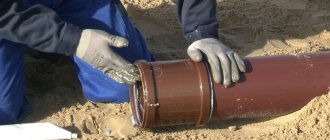February 26, 2020
Bends GOST 17375-2001 and other types
Bends are a piece of curved pipe. The bending angle can be 30, 45, 60, 90 and 180 degrees. For the manufacture of bends, steel of different grades is used. Also, bends can be made of polymers.
Bends are manufactured using a seamless and welded method. They can be steeply curved and bent. Steeply curved bends have a small radius and dimensions. Bent elbows are larger and have a larger radius. They are used where the operation of steeply curved bends is impossible.
GOST 30753 bends and other types of bends are needed in those sections of the pipeline where it makes a turn to change direction. Steel bends can withstand the highest temperatures and adverse conditions, so they can be used in aggressive work environments. At the same time, their service life will be quite long.
Bends can have a variety of angles, but the most popular are 45 and 90 degrees.
Description
A bend is a piece of pipe that is given a certain angle. Depending on the task, you can select a suitable outlet. There are many varieties, and this article is about them.
The bends are closely connected to the pipes by welding. According to GOST, such products are produced on special pipe bending machines.
WELDED SECTIONAL BENDS
Application
The scope of application of bends is very wide: from the installation of an oil pipeline to the installation of a boiler room in a residential building. Water pipelines, gas pipelines, oil pipelines - wherever pipes are used, bends are used.
Pipe rotator
In production, welding of bends to pipes is carried out using special equipment. Typically, these special equipment are rotators. The parts to be welded are clamped in the device and rotate around their axis, which makes it possible to perform high-quality welding of the outlet.
Let's consider the main advantages of using a rotator when welding a rotary product with a pipe:
- allow you to weld pipes with large diameters;
- the use of an autonomous drive in the rotator design allows you to regulate the rotation speed of the part;
- ensure precise alignment of pipes;
- can work not only with straight parts, but also with more complex, from a structural point of view, elements (for example, tees).
Today, there are many types of bends that allow you to solve any problem when installing pipelines. At the same time, a wide range of these products obliges specialists to study a large amount of information in order to know and comply with the features and rules for using all such products.
Classification of bends
Bends differ primarily in the materials from which they are made. In addition, they can have different diameters and bending angles. Each tap corresponds to a brand defined by GOST, by which you can find out all the necessary information about the product.
1 - steel pipe; 2 — thermal insulation made of polyurethane foam; 3 - galvanized shell; 4 - UEC system cable
Kinds
BENDED BRANDS
There are three types of steel bends, differing in the type of steel from which they are made. They can be made of stainless, alloy or carbon steel. Different types of bends are used for different purposes. The material from which it is made depends on the environmental conditions in which it will be used.
Size
If the diameter of the pipes used in the pipeline is less than 50 mm, steel bends are used for their branches. Such products can be welded or seamless. It depends on how the product is made. Seamless fittings are of higher quality and more expensive.
Production
Production of steeply curved bends from steel and stainless steel pipes
It also depends on the production method whether the bends will be stamped, cold-formed, or something else.
We recommend: Types and features of carbines
Sewerage
There are much fewer docking methods here.
Cast iron
Traditionally, chasing is used to connect cast iron sewers:
- The pipe is inserted into the socket of the fitting;
- The space between them is tightly caulked with kabalka - oiled organic fiber;
- Then the joint is covered with cement mortar or filled with molten sulfur.
Accordingly, fittings are a combination of bends with the same diameter as the pipes and sockets.
However, new cast iron sewer fittings and pipes are increasingly equipped with rubber seals, ensuring tightness during ordinary joining.
PVC and polyethylene
Both polyethylene and the much more common PVC pipes for sewerage, and fittings for them, are again equipped with rubber seals in the sockets.
There are two subtleties associated with docking:
- It is advisable to remove the outer chamfer from a pipe cut to size. Otherwise, it will be difficult to insert it into the rubber-sealed socket.
- A connection made with sealant is guaranteed not to leak due to drying of the rubber.
Tightness is ensured by a rubber seal; The sealant additionally fixes the pipe and protects against leaks when the rubber dries.
Which outlet should I choose?
It depends on the purpose for which it is purchased. If these are large diameter pipes, then it is better to use sectional bends.
Sectional welded bends
As mentioned above, steel bends are used in a huge number of areas. These include both household and industrial sectors.
Characteristics
Fittings that are designed for industrial use can withstand a wide range of temperatures, from -60 to 450 degrees.
Parts of this type must be protected from substances that can harm them at the chemical level (acids, alkalis). The bends are designed for a pressure of 16 MPa. The diameter can vary from 32 to 426 mm.
Steel bends are used in the energy industry.
Helpful information
DN - nominal diameter; D – outer diameter at the ends of the outlet; T is the wall thickness of the outlet at the ends of the outer diameter; Tb – wall thickness of bends in non-end sections; C is the size between the centers of the ends of bends with an angle of 180°; B is the size between the plane of the ends and the point of the outer surface of the bends most distant from it with an angle of 180°; F is the size between the plane of one end and the center of the other end of bends with an angle of 90°; H - the size between the end plane and the point of intersection of the tangents to the center line at the points of its intersection with the planes of the ends of the bends with an angle of 45°; R is the radius of curvature of the center line (bending radius) of the bends; W is the size between the end plane and the point of intersection of the tangents to the center line at the points of its intersection with the planes of the ends of bends with an angle of 60°.
Buy bends, send a request - [email protected] or look at photos of bends according to GOST 17375 in the Catalog.
To calculate transportation costs for transportation of bends:
Weight of 30° bend = weight of 90° bend multiplied by a factor of 0.4.
Weight of 45° bend = weight of 90° bend multiplied by a factor of 0.5.
Weight of 60° bend = weight of 90° bend multiplied by a factor of 0.7.
Weight of 180° bend = weight of 90° bend multiplied by factor 2.
Table 1. Weight and dimensions of bends GOST 17375-01 Version 1 :
| DN | D | T (wall) | F = R | H | WITH | IN | Weight, kg, 1 bend 90° | |||||
| 15 | 21,3 | 2/3,2/4 | 28 | 14 | 56 | 38 | 0,04 | 0,06 | 0,07 | |||
| 20 | 26,9 | 2/3,2/4 | 29 | 14 | 58 | 43 | 0,06 | 0,08 | 0,10 | |||
| 25 | 33,7 | 2,3/3,2/4,5 | 38 | 18 | 76 | 56 | 0,11 | 0,16 | 0,19 | |||
| 32 | 42,4 | 2,6/3,6/5 | 48 | 23 | 96 | 69 | 0,19 | 0,26 | 0,35 | |||
| 40 | 48,3 | 2,6/3,6/5 | 57 | 29 | 114 | 82 | 0,26 | 0,36 | 0,47 | |||
| 50 | 60,3 | 2,9/4/5,6 | 76 | 35 | 152 | 106 | 0,50 | 0,67 | 0,89 | |||
| 65 | 76,1 | 2,9/5/7,1 | 95 | 44 | 190 | 133 | 0,79 | 1,50 | 1,80 | |||
| 80 | 88,9 | 3,2/5,6/8 | 114 | 51 | 228 | 159 | 1,20 | 2,10 | 2,80 | |||
| 100 | 114,3 | 3,6/6,3/8,8 | 152 | 64 | 304 | 210 | 2,40 | 4 | 5,40 | |||
| 125 | 139,7 | 4,0/6,3/10 | 190 | 79 | 380 | 260 | 4,00 | 6,20 | 9,60 | |||
| 150 | 168,3 | 4,5/7,1/11 | 229 | 95 | 457 | 313 | 6,50 | 10 | 15 | |||
| 200 | 219,1 | 6,3/8/12,5 | 305 | 127 | 610 | 414 | 16 | 20 | 31 | |||
| 250 | 273,0 | 6,3/10 | 381 | 159 | 762 | 518 | 25 | 39 | ||||
| 300 | 323,9 | 7,1/10 | 457 | 190 | 914 | 619 | 40 | 56 | ||||
| 350 | 355,6 | 8/11 | 533 | 222 | 1066 | 711 | 57,00 | 78 | ||||
| 400 | 406,4 | 8,8/12,5 | 610 | 254 | 1220 | 813 | 82,00 | 117 | ||||
| 450 | 457,0 | 10,0 | 686 | 286 | 1372 | 914 | 119,00 | |||||
| 500 | 508,0 | 11,0 | 762 | 318 | 1524 | 1016 | 162,00 | |||||
| 600 | 610,0 | 12,5 | 914 | 381 | 1828 | 1219 | 266,00 | |||||
| 700 | 711,0 | — | 1067 | 444 | 2134 | 1422 | — | |||||
| 800 | 813,0 | — | 1219 | 507 | 2238 | — | — | |||||
| 900 | 914,0 | — | 1372 | 570 | 2744 | — | — | |||||
| 1000 | 1016,0 | — | 1524 | 634 | 3048 | — | — | |||||
Table 2. Weight and dimensions of bends GOST 17375-01 Version 2
| DN | D | T (wall) | F = R | W | N | WITH | IN | Weight of 90° bend, kg |
| 25 | 32 | 2 | 38 | 22 | 18 | 76 | 56 | 0,1 |
| 2,5 | 0,2 | |||||||
| 3 | 0,2 | |||||||
| 3,5 | 0,2 | |||||||
| 32 | 38 | 2 | 48 | 28 | 23 | 96 | 69 | 0,2 |
| 2,5 | 0,2 | |||||||
| 3 | 0,2 | |||||||
| 3,5 | 0,3 | |||||||
| 4 | 0,3 | |||||||
| 40 | 45 | 2,5 | 60 | 35 | 25 | 120 | 83 | 0,3 |
| 3 | 0,3 | |||||||
| 3,5 | 0,4 | |||||||
| 4 | 0,4 | |||||||
| 5 | 0,5 | |||||||
| 50 | 57 | 2,5 | 75 | 43 | 80 | 150 | 104 | 0,4 |
| 3 | 0,5 | |||||||
| 3,5 | 0,6 | |||||||
| 4 | 0,7 | |||||||
| 4,5 | 0,7 | |||||||
| 5 | 0,8 | |||||||
| 5,5 | 0,9 | |||||||
| 6 | 1 | |||||||
| 65 | 76 | 3 | 100 | 57 | 41 | 200 | 138 | 0,8 |
| 3,5 | 1 | |||||||
| 4 | 1,1 | |||||||
| 4,5 | 1,3 | |||||||
| 5 | 1,4 | |||||||
| 5,5 | 1,6 | |||||||
| 6 | 1,7 | |||||||
| 7 | 2 | |||||||
| 8 | 2,2 | |||||||
| 80 | 89 | 3 | 120 | 69 | 50 | 240 | 165 | 1,2 |
| 3,5 | 1,4 | |||||||
| 4 | 1,5 | |||||||
| 4,5 | 1,7 | |||||||
| 5 | 1,9 | |||||||
| 5,5 | 2,1 | |||||||
| 6 | 2,3 | |||||||
| 7 | 2,7 | |||||||
| 8 | 3 | |||||||
| 100 | 102 | 3,5 | 150 | 87 | 62 | 300 | 201 | 2,1 |
| 4 | 2,4 | |||||||
| 4,5 | 2,6 | |||||||
| 5 | 2,9 | |||||||
| 6 | 3,4 | |||||||
| 7 | 3,9 | |||||||
| 8 | 4,5 | |||||||
| 9 | 5 | |||||||
| 10 | 5,5 | |||||||
| 108 | 3,5 | 204 | 2,2 | |||||
| 4 | 2,5 | |||||||
| 4,5 | 2,8 | |||||||
| 50 | 3,1 | |||||||
| 6 | 3,6 | |||||||
| 7 | 4,1 | |||||||
| 8 | 4,7 | |||||||
| 9 | 5,3 | |||||||
| 10 | 5,8 | |||||||
| 114 | 3,5 | 207 | 2,2 | |||||
| 4 | 2,6 | |||||||
| 4,5 | 2,9 | |||||||
| 5 | 3,3 | |||||||
| 6 | 3,8 | |||||||
| 7 | 4,4 | |||||||
| 8 | 5 | |||||||
| 9 | 5,7 | |||||||
| 10 | 6,1 | |||||||
| 125 | 133 | 3,5 | 190 | 110 | 79 | 380 | 257 | 3,3 |
| 4 | 3,8 | |||||||
| 4,5 | 4,3 | |||||||
| 5 | 4,8 | |||||||
| 6 | 5,7 | |||||||
| 7 | 6,5 | |||||||
| 8 | 7,4 | |||||||
| 9 | 8,2 | |||||||
| 10 | 9,1 | |||||||
| 11 | 10 | |||||||
| 12 | 11 | |||||||
| 150 | 159 | 4 | 225 | 130 | 93 | 450 | 305 | 5,4 |
| 4,5 | 6,1 | |||||||
| 5 | 6,7 | |||||||
| 6 | 8,1 | |||||||
| 7 | 9,4 | |||||||
| 8 | 11 | |||||||
| 9 | 12 | |||||||
| 10 | 13 | |||||||
| 11 | 14 | |||||||
| 12 | 16 | |||||||
| 13 | 17 | |||||||
| 14 | 18 | |||||||
| 168 | 4 | 5,6 | ||||||
| 4,5 | 6,4 | |||||||
| 5 | 7,1 | |||||||
| 6 | 8,5 | |||||||
| 7 | 9,8 | |||||||
| 8 | 11,2 | |||||||
| 9 | 12,5 | |||||||
| 10 | 14 | |||||||
| 11 | 15 | |||||||
| 12 | 16 | |||||||
| 13 | 17,5 | |||||||
| 14 | 19 | |||||||
| 200 | 219 | 5 | 300 | 173 | 124 | 600 | 410 | 13 |
| 6 | 15 | |||||||
| 7 | 17 | |||||||
| 8 | 20 | |||||||
| 9 | 22 | |||||||
| 10 | 25 | |||||||
| 11 | 27 | |||||||
| 12 | 29 | |||||||
| 13 | 32 | |||||||
| 14 | 34 | |||||||
| 15 | 37 | |||||||
| 16 | 39 | |||||||
| 17 | 42 | |||||||
| 18 | 44 | |||||||
| 250 | 273 | 6 | 375 | 217 | 155 | 750 | 512 | 23 |
| 7 | 27 | |||||||
| 8 | 31 | |||||||
| 9 | 35 | |||||||
| 10 | 39 | |||||||
| 11 | 43 | |||||||
| 12 | 46 | |||||||
| 13 | 50 | |||||||
| 14 | 54 | |||||||
| 15 | 58 | |||||||
| 16 | 61 | |||||||
| 17 | 66 | |||||||
| 18 | 70 | |||||||
| 20 | 78 | |||||||
| 22 | 85 | |||||||
| 300 | 325 | 7 | 450 | 260 | 186 | 900 | 613 | 39 |
| 8 | 45 | |||||||
| 9 | 50 | |||||||
| 10 | 56 | |||||||
| 11 | 61 | |||||||
| 12 | 66 | |||||||
| 13 | 72 | |||||||
| 14 | 77 | |||||||
| 15 | 82 | |||||||
| 16 | 87 | |||||||
| 17 | 92 | |||||||
| 18 | 96 | |||||||
| 20 | 107 | |||||||
| 22 | 118 | |||||||
| 24 | 130 | |||||||
| 26 | 141 | |||||||
| 28 | 150 | |||||||
| 350 | 377 | 9 | 525 | 303 | 217 | 1050 | 714 | 68 |
| 10 | 75 | |||||||
| 11 | 83 | |||||||
| 12 | 90 | |||||||
| 13 | 97 | |||||||
| 14 | 104 | |||||||
| 15 | 112 | |||||||
| 16 | 119 | |||||||
| 18 | 133 | |||||||
| 20 | 147 | |||||||
| 22 | 161 | |||||||
| 24 | 175 | |||||||
| 26 | 188 | |||||||
| 28 | 201 | |||||||
| 30 | 214 | |||||||
| 32 | 228 | |||||||
| 400 | 426 | 8 | 600 | 346 | 248 | 1200 | 813 | 78 |
| 9 | 87 | |||||||
| 10 | 97 | |||||||
| 11 | 107 | |||||||
| 12 | 117 | |||||||
| 13 | 126 | |||||||
| 14 | 135 | |||||||
| 15 | 145 | |||||||
| 16 | 154 | |||||||
| 17 | 164 | |||||||
| 18 | 173 | |||||||
| 20 | 192 | |||||||
| 22 | 210 | |||||||
| 24 | 230 | |||||||
| 26 | 249 | |||||||
| 28 | 268 | |||||||
| 30 | 286 | |||||||
| 32 | 306 | |||||||
| 34 | 324 | |||||||
| 500 | 530 | 9 | 750 | 433 | 310 | 1500 | 1015 | 138 |
| 10 | 153 | |||||||
| 11 | 168 | |||||||
| 12 | 183 | |||||||
| 13 | 198 | |||||||
| 14 | 212 | |||||||
| 15 | 227 | |||||||
| 16 | 242 | |||||||
| 17 | 256 | |||||||
| 18 | 270 | |||||||
| 20 | 298 | |||||||
| 22 | 327 | |||||||
| 24 | 356 | |||||||
| 26 | 385 | |||||||
| 28 | 413 | |||||||
| 30 | 440 | |||||||
| 32 | 467 | |||||||
| 34 | 494 | |||||||
| 36 | 520 | |||||||
| 600 | 630 | 9 | 900 | 519 | 373 | 1800 | 1215 | 198 |
| 10 | 219 | |||||||
| 11 | 245 | |||||||
| 12 | 261 | |||||||
| 13 | 282 | |||||||
| 14 | 302 | |||||||
| 15 | 324 | |||||||
| 16 | 345 | |||||||
| 17 | 366 | |||||||
| 18 | 387 | |||||||
| 20 | 429 | |||||||
| 22 | 471 | |||||||
| 24 | 513 | |||||||
| 26 | 554 | |||||||
| 28 | 595 | |||||||
| 30 | 636 | |||||||
| 32 | 678 | |||||||
| 700 | 720 | 9 | 1000 | 577 | 404 | 2000 | 1360 | 248 |
| 10 | 275 | |||||||
| 11 | 302 | |||||||
| 12 | 329 | |||||||
| 13 | 356 | |||||||
| 14 | 383 | |||||||
| 15 | 410 | |||||||
| 16 | 436 | |||||||
| 17 | 462 | |||||||
| 18 | 489 | |||||||
| 20 | 542 | |||||||
| 22 | 595 | |||||||
| 24 | 647 | |||||||
| 26 | 698 | |||||||
| 28 | 750 | |||||||
| 30 | 801 | |||||||
| 32 | 852 | |||||||
| 800 | 820 | 9 | 1200 | 693 | 485 | 2400 | 1610 | 339 |
| 10 | 376 | |||||||
| 11 | 413 | |||||||
| 12 | 450 | |||||||
| 13 | 487 | |||||||
| 14 | 524 | |||||||
| 15 | 561 | |||||||
| 16 | 598 | |||||||
| 17 | 636 | |||||||
| 18 | 670 | |||||||
| 20 | 743 | |||||||
| 22 | 815 | |||||||
| 24 | 887 | |||||||
| 26 | 959 | |||||||
| 28 | 1030 | |||||||
| 30 | 1101 | |||||||
| 32 | 1171 |
Examples of symbols for bends according to GOST 17375-2001:
Bend 90°, version 2, diameter 219 mm, wall thickness 8 mm, made of steel grade 09G2S: Bend 90-2-219x8-09G2S GOST 17375-2001
Bend 45°, version 1, diameter 60.3 mm, wall thickness 2.9 mm, made of steel grade 20: Bend 45-1-60.3x2.9-20 GOST 17375-2001
Table 3. Weight and dimensions of bends GOST 30753- 01 Version 1
| DN | D | T (wall) | F | WITH | IN | Weight, kg, 1 bend 90° |
| 50 | 60,3 | 4,0 | 51 | 102 | 81 | 0,44 |
| 65 | 76,1 | 5,0 | 63 | 127 | 102 | 0,87 |
| 80 | 88,9 | 5,6 | 76 | 152 | 121 | 1,40 |
| 100 | 114,3 | 6,3 | 102 | 203 | 159 | 2,60 |
| 125 | 139,7 | 6,3 | 127 | 254 | 197 | 4,10 |
| 150 | 168,3 | 7,1 | 152 | 305 | 237 | 6,70 |
| 200 | 219,1 | 8,0 | 203 | 406 | 313 | 13,00 |
| 250 | 273,0 | 10,0 | 254 | 508 | 391 | 26,00 |
| 300 | 323,9 | 10,0 | 305 | 610 | 467 | 37,00 |
| 350 | 355,6 | 11,0 | 356 | 711 | 533 | 52,00 |
| 400 | 406,4 | 12,5 | 406 | 813 | 610 | 77,00 |
| 450 | 457,0 | — | 457 | 914 | 686 | — |
| 500 | 508,0 | — | 508 | 1016 | 762 | — |
| 600 | 610,0 | — | 610 | 1220 | 914 | — |
Table 4. Weight and dimensions of bends GOST 30753-01 Version 2
| DN | D | T | F = R | W | H | WITH | B | Weight of bend θ = 90°, kg |
| 50 | 57 | 4 | 50 | 29 | 21 | 100 | 79 | 0,4 |
| 5 | 0,5 | |||||||
| 6 | 0,6 | |||||||
| 65 | 76 | 5 | 65 | 37 | 27 | 130 | 103 | 0,9 |
| 6 | 1,1 | |||||||
| 7 | 1,2 | |||||||
| 80 | 89 | 5 | 80 | 46 | 33 | 160 | 125 | 1,3 |
| 6 | 1,6 | |||||||
| 7 | 1,8 | |||||||
| 8 | 2,1 | |||||||
| 100 | 102 | 5 | 100 | 58 | 41 | 200 | 151 | 1,9 |
| 6 | 2,3 | |||||||
| 8 | 3,0 | |||||||
| 10 | 3,7 | |||||||
| 108 | 5 | 154 | 2,1 | |||||
| 6 | 2,4 | |||||||
| 8 | 3,1 | |||||||
| 10 | 3,9 | |||||||
| 114 | 5 | 203 | 159 | 2,2 | ||||
| 6 | 2,5 | |||||||
| 8 | 3,3 | |||||||
| 10 | 4,1 | |||||||
| 125 | 133 | 5 | 125 | 72 | 52 | 250 | 192 | 3,0 |
| 6 | 3,6 | |||||||
| 8 | 4,9 | |||||||
| 10 | 6,1 | |||||||
| 12 | 7,3 | |||||||
| 150 | 159 | 5 | 150 | 87 | 62 | 300 | 230 | 4,5 |
| 6 | 5,4 | |||||||
| 8 | 7,1 | |||||||
| 10 | 8,7 | |||||||
| 12 | 11,0 | |||||||
| 14 | 12,0 | |||||||
| 168 | 5 | 234 | 4,7 | |||||
| 6 | 5,6 | |||||||
| 8 | 7,5 | |||||||
| 10 | 9,4 | |||||||
| 12 | 11,0 | |||||||
| 14 | 13,0 | |||||||
| 200 | 219 | 7 | 200 | 115 | 83 | 400 | 310 | 12,0 |
| 8 | 13,0 | |||||||
| 10 | 16,0 | |||||||
| 12 | 19,0 | |||||||
| 16 | 25,0 | |||||||
| 18 | 29,0 | |||||||
| 250 | 273 | 9 | 250 | 158 | 103 | 500 | 387 | 24,0 |
| 10 | 26,0 | |||||||
| 12 | 31,0 | |||||||
| 16 | 42,0 | |||||||
| 18 | 47,0 | |||||||
| 20 | 52,0 | |||||||
| 22 | 57,0 | |||||||
| 24 | 60,0 | |||||||
| 300 | 325 | 9 | 300 | 173 | 124 | 600 | 463 | 34,0 |
| 10 | 37,0 | |||||||
| 12 | 45,0 | |||||||
| 14 | 52,0 | |||||||
| 16 | 59,0 | |||||||
| 18 | 67,0 | |||||||
| 20 | 74,0 | |||||||
| 22 | 81,0 | |||||||
| 24 | 89,0 | |||||||
| 26 | 96,0 | |||||||
| 28 | 102,0 | |||||||
| 350 | 377 | 10 | 350 | 202 | 145 | 700 | 539 | 47,0 |
| 12 | 57,0 | |||||||
| 16 | 76,0 | |||||||
| 18 | 85,0 | |||||||
| 20 | 94,0 | |||||||
| 24 | 113,0 | |||||||
| 26 | 122,0 | |||||||
| 30 | 141,0 | |||||||
| 400 | 426 | 10 | 400 | 231 | 166 | 800 | 613 | 64,0 |
| 12 | 77,0 | |||||||
| 16 | 103,0 | |||||||
| 18 | 116,0 | |||||||
| 22 | 142,0 | |||||||
| 24 | 155,0 | |||||||
| 26 | 167,0 | |||||||
| 28 | 180,0 | |||||||
| 32 | 206,0 | |||||||
| 34 | 219,0 | |||||||
| 36 | 130,0 | |||||||
| 500 | 530 | 9 | 500 | 289 | 207 | 1000 | 765 | 92,0 |
| 10 | 102,0 | |||||||
| 12 | 122,0 | |||||||
| 14 | 143,0 | |||||||
| 16 | 161,0 | |||||||
| 18 | 184,0 | |||||||
| 20 | 204,0 | |||||||
| 22 | 223,0 | |||||||
| 24 | 243,0 | |||||||
| 26 | 262,0 | |||||||
| 28 | 282,0 | |||||||
| 30 | 300,0 | |||||||
| 32 | 320,0 | |||||||
| 34 | 340,0 | |||||||
| 36 | 365,0 | |||||||
| 600 | 630 | 9 | 600 | 346 | 248 | 1200 | 915 | 131,0 |
| 10 | 146,0 | |||||||
| 12 | 174,0 | |||||||
| 14 | 200,0 | |||||||
| 16 | 230,0 | |||||||
| 18 | 261,0 | |||||||
| 20 | 290,0 | |||||||
| 22 | 319,0 | |||||||
| 24 | 346,0 | |||||||
| 26 | 371,0 | |||||||
| 28 | 400,0 | |||||||
| 30 | 428,0 | |||||||
| 32 | 460,0 | |||||||
| 34 | 489,0 | |||||||
| 36 | 518,0 | |||||||
| 700 | 720 | 9 | 700 | 405 | 283 | 1400 | 1060 | 174,0 |
| 10 | 193,0 | |||||||
| 12 | 230,0 | |||||||
| 14 | 268,0 | |||||||
| 16 | 306,0 | |||||||
| 18 | 343,0 | |||||||
| 20 | 380,0 | |||||||
| 22 | 416,0 | |||||||
| 24 | 453,0 | |||||||
| 26 | 489,0 | |||||||
| 28 | 525,0 | |||||||
| 30 | 561,0 | |||||||
| 32 | 596,0 | |||||||
| 34 | 632,0 | |||||||
| 36 | 667,0 | |||||||
| 800 | 820 | 9 | 800 | 462 | 324 | 1600 | 1220 | 226,0 |
| 10 | 251,0 | |||||||
| 12 | 301,0 | |||||||
| 14 | 350,0 | |||||||
| 16 | 399,0 | |||||||
| 18 | 447,0 | |||||||
| 20 | 496,0 | |||||||
| 22 | 544,0 | |||||||
| 24 | 592,0 | |||||||
| 26 | 640,0 | |||||||
| 28 | 687,0 | |||||||
| 30 | 734,0 | |||||||
| 32 | 781,0 | |||||||
| 34 | 828,0 | |||||||
| 36 | 874,0 | |||||||
| Notes 1 Weight is for reference only. 2 The mass of bends with θ = 60° and θ = 45° is 1.5 and 2 times less, respectively, and the mass of bends with θ = 180° is 2 times more than indicated. | ||||||||
Source Design, Pipeline
December 16, 2021
Back
Peculiarities
Low-density polyethylene is another material from which pipes and bends for them can be made. They have the following positive qualities:
• Such pipes do not rust or oxidize. • They are lightweight. • They are not afraid of aggressive environmental influences. • They are elastic. • Bends made of HDPE have high strength characteristics. • They are able to provide stable pressure in the pipeline.
The polyethylene bends in question allow you to save considerable amounts of money on transportation. This is not surprising if we remember that they are several times lighter than their metal prototypes.
Advantages
Another undoubted advantage of such parts is their ease of installation. In order to assemble a pipeline from this material, there is no need to use welding, and this saves on electricity or gas, depending on what type of welding would be used if the pipes were made of metal.
Bends for PPU pipes
A material with similar positive qualities from which pipes and bends can be made is PVC. Below is a list of these benefits.
We recommend: Knife gate valve with electric drive for chimney
1. Relatively small specific gravity. 2. Durability with proper use. 3. Ease of installation. 4. Reasonable price.
PVC pipes are not afraid of almost any environmental factors. These factors include temperature changes, rusting, moisture, chemically active substances, and ultraviolet radiation. The sections will not become overgrown and the pipe walls will not become thinner.
Plumbing and heating
Steel pipes
This category includes pipes made of black steel and galvanized, which are not afraid of corrosion. Most often they are welded by electric welding or gas, but not always.
To connect them, two types of fittings are used:
- Threaded. Couplings, angles, tees, adapters and locknuts are made of brass (often chrome-plated) or cast iron. The advantage is the exceptional mechanical strength of the connection. The main disadvantage is the laboriousness of assembly and the need to precisely adjust the length of the pipes and threads.
Threaded fittings made of chrome plated brass.
- Compression fittings use a silicone or rubber seal that, when the nut is tightened, tightly compresses the pipe. Their price is noticeably higher; however, they provide simple and quick installation in problem areas where neither pipe threading nor welding is possible. The main disadvantage, in addition to cost, is the lower mechanical strength of the connection.
Copper pipes
Their connections are usually soldered with a gas torch using flux and solder. Copper fittings include angles, crosses, tees and solder elbows. Before joining using rolling, a sleeve is formed on one of the joined products, into which the edge of the other is inserted.
Metal-plastic
Between the two layers of plastic there is a layer of aluminum that gives the structure rigidity and strength. Pipes are supplied in coils, which eliminates the need for splicing short sections.
When a fork is formed or plumbing is connected to the water supply, one of two types of fittings is used:
Compression in this case is somewhat different from what is used with steel pipes. The aluminum layer of metal-plastic is quite plastic; in order to ensure the strength of the connection, a union nut and a split ring are put on the calibrated end of the pipe, after which the fitting is inserted into the pipe. The nut, which is then tightened on it, compresses the pipe onto the fitting using a split ring and makes the connection airtight. This connection is very easy to assemble with the simplest tools; however, it is not suitable for hot water and heating. After several heating and cooling cycles, the fitting begins to leak.
Metal-plastic corner - thread with compression connection.
Polypropylene
Here the assembly instructions are also not very complicated: the pipe on the outside and the fitting on the inside are melted with a low-temperature soldering iron with a nozzle of the appropriate diameter, after which their surfaces are aligned. A few seconds - and we have a solid product in our hands.
Both pipes and elements for connecting them are the cheapest. However, in addition to cold water, they should be used primarily in autonomous hot water supply and heating systems: the combination of high temperature and a pressure surge during water hammer may well lead to rupture of the liner or riser.
The photo shows tees on a polypropylene water supply.
Polyethylene
Ordinary polyethylene is used exclusively for cold water.
Pipes are connected in several ways:
- Compression fittings for cold water can be made of the same polyethylene and equipped with rubber gaskets. They are easy to install without any tools; however, the bond strength is low. However, you can also find brass fittings for HDPE pipes on sale.
- Low-temperature soldering using a soldering iron is also used here. Polyethylene plumbing fittings for soldering are cheap, but, alas, they are not on sale everywhere.
- Finally, electric welded plumbing fittings differ from the previous ones in that they are equipped with a heating element. After assembling the water supply, voltage is applied to each pair of contact terminals of the fitting - and after a few seconds the elements are soldered.
For hot water and heating, so-called cross-linked polyethylene is used, which differs from conventional polyethylene in strength and heat resistance. During installation, the pipe is stretched with a special expander and put on a fitting, which, thanks to the molecular memory effect, turns out to be very tightly compressed within a dozen or two seconds. Additional fixation of the connection is provided by a sleeve placed on the outside.
Corrugated stainless steel
The design of its fitting almost exactly replicates the compression connection for a steel pipe. However, thanks to the corrugated surface, the connection is not only airtight, but also extremely durable: it is almost impossible to tear out a section of the water pipe.
Adapter from corrugated stainless steel to regular thread.
Installation
Such pipes and bends can be installed without any additional tools. The parts are simply inserted into each other, forming a firmly connected, inextricable system. Installation of PVC pipeline parts is possible for novice builders.
Bends can also be divided into welded and cold-formed. Welded fittings can be made from different types of metal. This includes carbon steel, stainless steel, and low-alloy steel. Like other taps, they can be used in almost all areas of human activity.
In order to make segment bends, individual pipe rings made like a wedge are welded together. Such parts are used for gas and water pipelines, the pressure in which does not exceed low limits.
These bends are useful in cases where it is necessary to connect sections of large diameter pipes together.
Existing sizes and diameters of bends
There are several possible angles at which a pipe bend can be deflected. These are 15, 30, 45 90 and 180 degrees.
Welded sector bends 60° and 90°
To know what size elbow to purchase, you need to know the diameter of the pipes it will connect. The diameter can vary from 426 mm to 2000. Manufacturers can also produce bends that are non-standard in diameter and deflection angle.
Sector bends
Purpose of the product
PVC bends for internal sewerage are needed to arrange the rotation of sewer pipes at a certain angle and are used for installing unclean water drainage systems in administrative and residential buildings.
Plastic connecting elements have a smooth interior, which greatly reduces the risk of clogging during operation, and virtually do not make noise when liquid flows through them.
In addition, their production uses material that is resistant to warm water (up to 95 degrees Celsius) and chemical detergents.
Dimensions of sewer plastic outlets: 110 and 50 mm (the diameter of the internal hole is measured).
As for angles, the standard values are:
There is another option: a branch with a diameter of 110 mm with access to pipes of a smaller diameter. They are used for various non-standard configurations.

